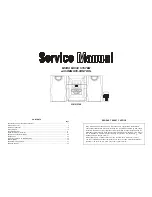
Chapter 14: Solo and Monitor Busses
111
Chapter 14: Solo and Monitor Busses
Solo Bus Modes
D-Show offers three modes for soloing channels in the system:
Pre-Fader Listen (PFL), After-Fader Listen (AFL) and Solo In
Place (SIP).
◆
In AFL or PFL mode, soloing only affects what you hear on
the dedicated stereo AFL/PFL Solo bus, which feeds the Moni-
tor Bus.
◆
In Solo In Place mode, soloing only affects what you hear in
the Main busses.
Pre-Fader Listen (PFL)
PFL Solo mode sends the signal from explicitly soloed Input
Channels and FX Returns to the AFL/PFL Solo bus. The signal
is post-insert, pre-fader and pre-mute.
Mono input signals are sent to both sides of the Solo bus, and
the left and right sides of stereo input signals are sent to the
corresponding sides of the Solo bus.
PFL is the default Solo mode.
After-Fader Listen (AFL)
AFL Solo mode sends the signal from explicitly soloed chan-
nels and solo-safe inputs to the AFL/PFL Solo bus. Soloing of
output busses is always AFL.
In AFL Solo mode, both input and output signals are sent to
the Solo bus post-fader and post-pan/balance, and are always
panned to stereo even if the Main busses are configured in
L–C–R mode.
Monitoring Aux busses and Variable Group busses with AFL
Linked Aux busses and Variable Group busses use true stereo
AFL. When you solo a linked Aux bus, the two busses are
heard as a stereo pair on the Solo bus.
Mono Aux busses and Variable Group busses are heard as dual
mono on the Solo bus.
Option for AFL to Bank Auxes
You can set D-Show to automatically display Aux or Variable
Group send controls on the Input Channel Encoders when
the corresponding Aux or Variable Group output bus is so-
loed. See “Auxes/Variable Groups Follow AFL” on page 112.
Solo In Place (SIP)
SIP Solo mode applies to Input Channels and FX Returns only.
Solo In Place sends the signal from the soloed channel to the
Main busses. No signal is sent to the Solo busses. Signal is sent
post-pan/balance.
To enter Solo In Place mode:
■
Press and hold the Solo in Place switch for 2 seconds. The
SIP switch lights to indicate SIP mode is active.
To exit Solo in Place mode:
■
Press the Solo in Place or Cancel switch to exit SIP mode.
Selecting a Solo Mode
The Solo mode can be selected from the Solo/PFL section or
on-screen.
To select the Solo mode from the Solo/PFL section, do one of the
following:
• Press the Stereo AFL switch to enter AFL Solo mode.
• Press and hold the Solo In Place switch for at least 2 sec-
onds to enter SIP mode.
• Press a lit Solo mode switch to turn it off. When no
switch is lit in the Solo/PFL section, the system is in PFL
mode.
In SIP Solo mode, audio is sent directly to the Main busses.
Use this feature with caution.
Solo bus controls
Level Trim
Solo Clear
Solo In Place
Stereo AFL
Mix to Monitors
Summary of Contents for D-Show Profile
Page 10: ...D Show Profile Guide x ...
Page 11: ...Part I Overview and Installation ...
Page 12: ......
Page 16: ...D Show Profile Guide 6 ...
Page 32: ...D Show Profile Guide 22 ...
Page 33: ...Part II System Description ...
Page 34: ......
Page 50: ...D Show Profile Guide 40 ...
Page 58: ...D Show Profile Guide 48 ...
Page 67: ...Part III Signal Routing ...
Page 68: ......
Page 94: ...D Show Profile Guide 84 ...
Page 102: ...D Show Profile Guide 92 ...
Page 110: ...D Show Profile Guide 100 ...
Page 134: ...D Show Profile Guide 124 ...
Page 135: ...Part IV Processing ...
Page 136: ......
Page 144: ...D Show Profile Guide 134 ...
Page 171: ...Part V Shows ...
Page 172: ......
Page 180: ...D Show Profile Guide 170 ...
Page 204: ...D Show Profile Guide 194 ...
Page 227: ...Part VI Specifications ...
Page 228: ......
Page 236: ...D Show Profile Guide 226 D Show Output Signal Flow Diagram Version 1 3 07 07 05 ...
Page 245: ...Part VII Reference ...
Page 246: ......
Page 258: ...D Show Profile Guide 248 ...
Page 269: ......
















































